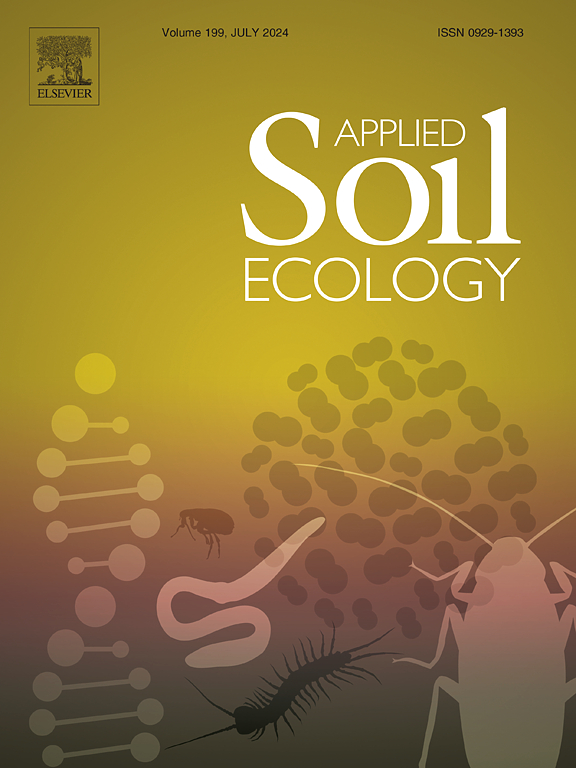Reliability of earthworm data from citizen science: Lessons from 7 years of a French national monitoring protocol
IF 5
2区 农林科学
Q1 SOIL SCIENCE
引用次数: 0
Abstract
Monitoring biodiversity is seldom comprehensive, as the spatio-temporal resolution needed to accurately reflect dynamic changes of these communities in diverse environments is often lacking. Citizen science offers a promising tool to help fill these gaps, engaging a wider audience in monitoring efforts and thus enhancing our understanding of earthworm ecology. However, a significant challenge arises as earthworms are difficult to identify to the species level in the field by non-experts, necessitating the use of morphotypes as taxonomic proxies. This study evaluates the reliability of earthworm classification into four earthworm morphotypes within the ‘500 ENI’ (Non-intended Effects) Monitoring Network in France. The network relies on annual sampling conducted in agricultural lands by non-specialist participants with subsequent identification verification by earthworm taxonomists. Analyzing >48,000 individual earthworms collected over 950 plots, we calculated two indices: the misclassification rate (MR) and the undetected rate (UR) to assess the reliability of classification into earthworm morphotypes. The results indicated an average MR of 28 % and an average UR of 32 %, which both varied according to morphotypes. Endogeics had lower error rates compared to epigeics, anecics with a red anterior, and anecics with a black anterior. Our findings underscored the significant impact of sampler experience and earthworm community composition on the reliability of classification of individuals into morphotypes by citizens. The results highlight the critical need for enhanced support and guidance for participants with limited experience. Furthermore, we recommend providing additional training or resources to aid in morphotype classification, especially for earthworm communities exhibiting low abundance, low adult proportion, or low morphotype diversity. Encouraging participants to sample during periods favorable for detecting reliable total and adult abundances would also help optimize morphotype detection.

来自公民科学的蚯蚓数据的可靠性:来自法国国家监测协议7年的经验教训
由于往往缺乏准确反映这些群落在不同环境中动态变化所需的时空分辨率,因此对生物多样性的监测很少是全面的。公民科学提供了一个很有前途的工具来帮助填补这些空白,让更广泛的受众参与到监测工作中来,从而增强我们对蚯蚓生态学的理解。然而,一个重大的挑战是蚯蚓很难被非专家在野外识别到物种水平,需要使用形态型作为分类代理。本研究评估了法国“500 ENI”(非预期影响)监测网络中蚯蚓分类为四种蚯蚓形态的可靠性。该网络依靠非专业参与者每年在农业土地上进行抽样,随后由蚯蚓分类学家进行鉴定核实。通过对950个样地48000只蚯蚓的分析,计算了误分类率(MR)和未检出率(UR)两个指标,评价了蚯蚓形态分类的可靠性。结果显示平均MR为28%,平均UR为32%,两者均根据形态而变化。内源性手术的错误率比外源性手术、前路红色手术和前路黑色手术的错误率低。我们的研究结果强调了采样者经验和蚯蚓群落组成对公民将个体分类为形态的可靠性的重要影响。研究结果突出表明,迫切需要加强对经验有限的参与者的支持和指导。此外,我们建议提供额外的培训或资源来帮助形态类型分类,特别是对那些表现出低丰度、低成虫比例或低形态类型多样性的蚯蚓群落。鼓励参与者在有利于检测可靠的总丰度和成年丰度的时期取样,也有助于优化形态检测。
本文章由计算机程序翻译,如有差异,请以英文原文为准。
求助全文
约1分钟内获得全文
求助全文
来源期刊

Applied Soil Ecology
农林科学-土壤科学
CiteScore
9.70
自引率
4.20%
发文量
363
审稿时长
5.3 months
期刊介绍:
Applied Soil Ecology addresses the role of soil organisms and their interactions in relation to: sustainability and productivity, nutrient cycling and other soil processes, the maintenance of soil functions, the impact of human activities on soil ecosystems and bio(techno)logical control of soil-inhabiting pests, diseases and weeds.
 求助内容:
求助内容: 应助结果提醒方式:
应助结果提醒方式:


